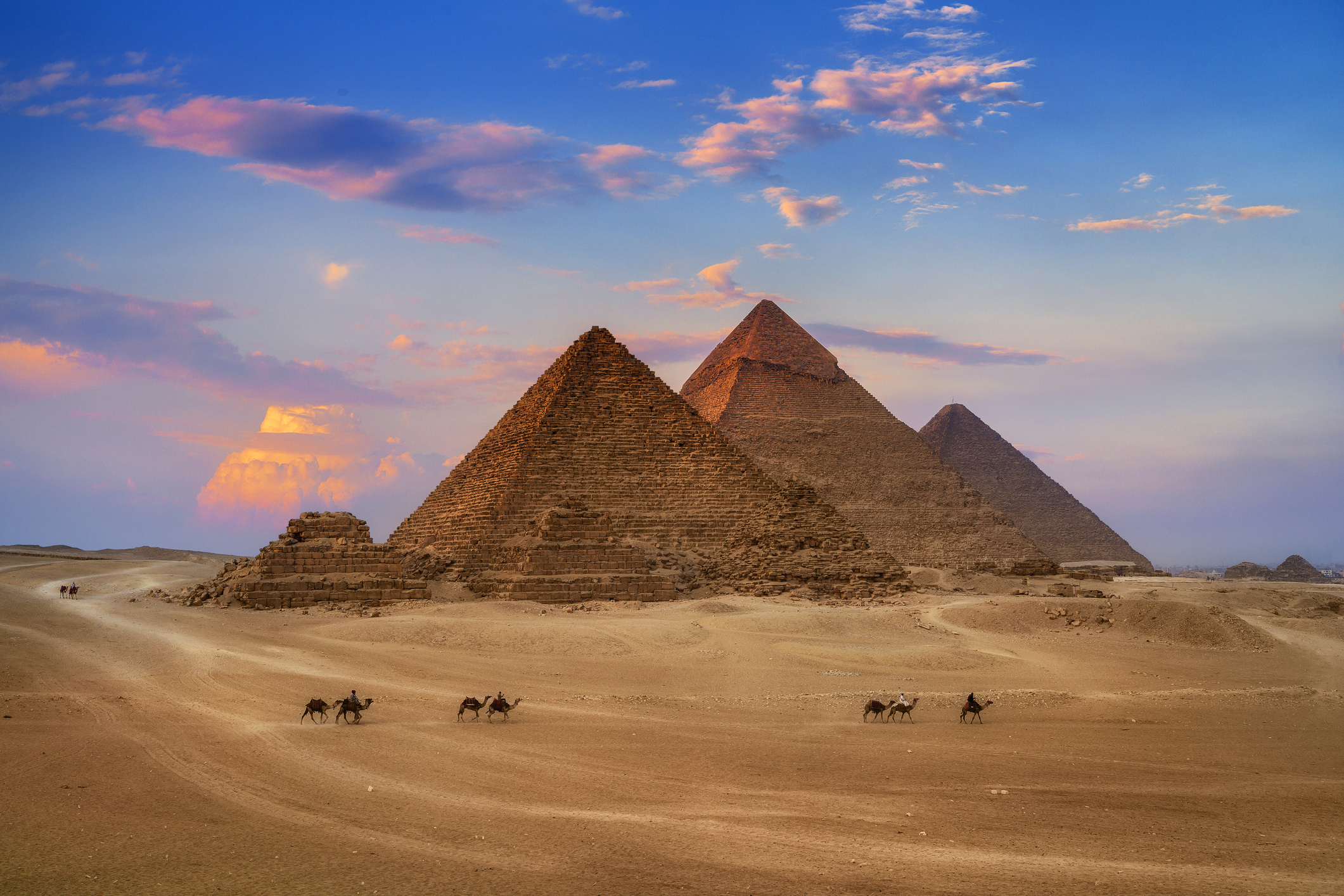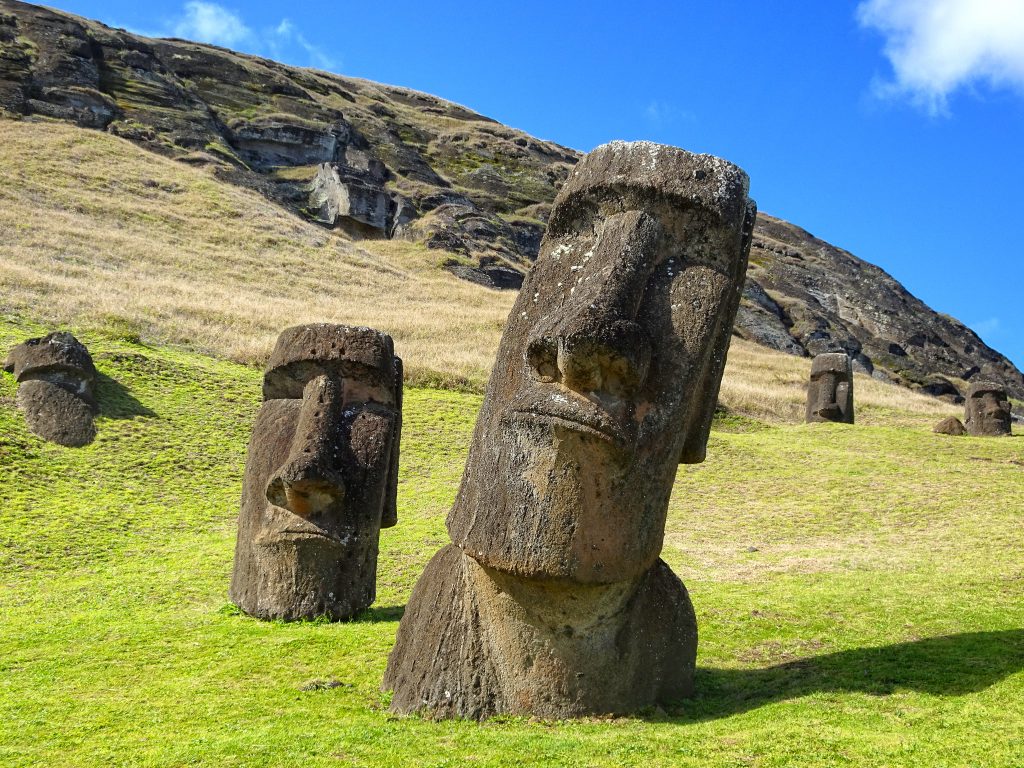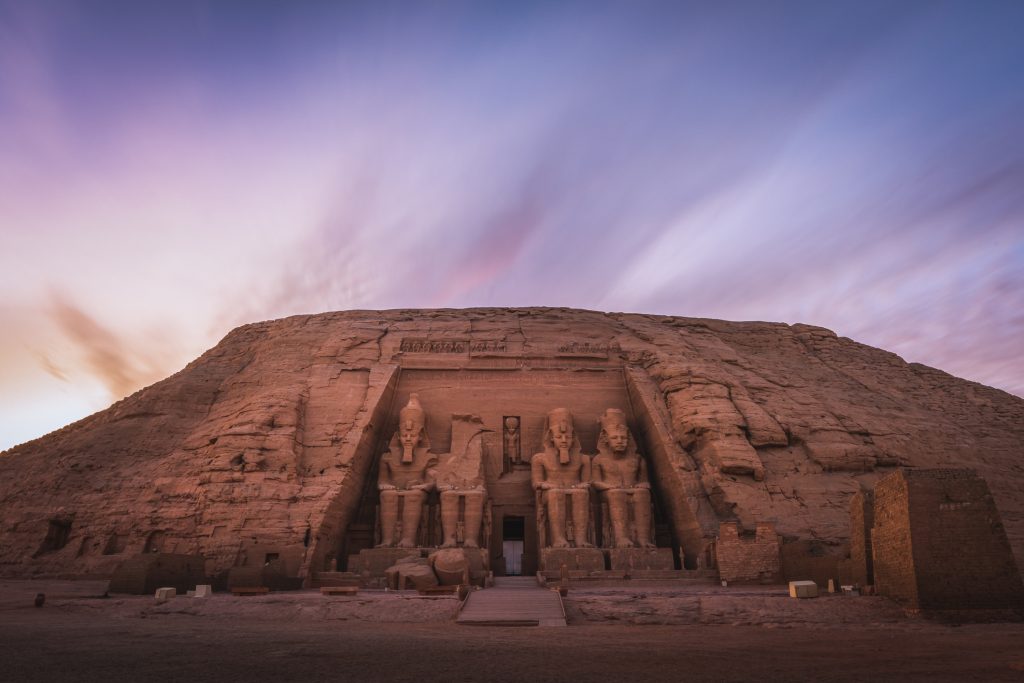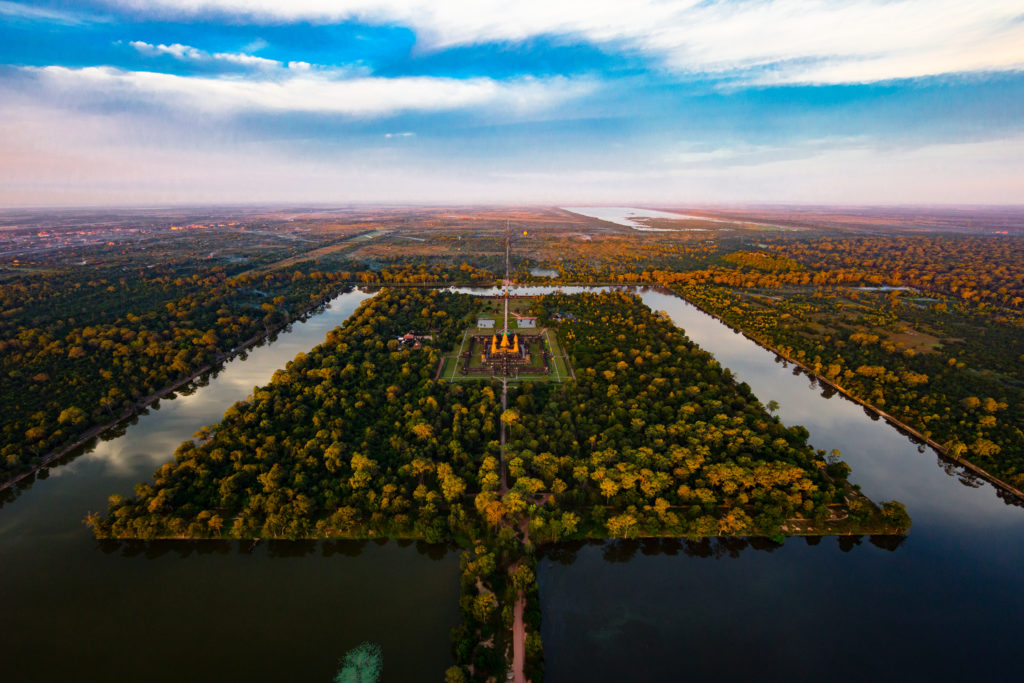Even after thousands of years, the three Pyramids of Giza are still some of the most iconic buildings on the planet. A spectacular feat of architecture, examining how the pyramids were built gives us a deeper appreciation of the incredible knowledge, skills, and dedication that their creators possessed.
Join us, as we explore the ancient mystery; how were the Pyramids of Giza built?
The 7 Wonders of the Ancient World
The three pyramids at Giza are the largest of all the pyramids found in Egypt, but they were not the first or the last pyramids to be built in the region. Each pyramid is named after the Old Kingdom pharaohs that are believed to have commissioned them. They are:
- The Great Pyramid, or Pyramid of Khufu: built first and is the tallest and largest.
- Pyramid of Khafre: the middle sized pyramid, built second and is the next largest.
- Pyramid of Menkaure: the smallest, built last.
Of the seven wonders of the ancient world, the Great Pyramid is the only one still standing. It is unique in that out of 35 pyramids that are built in the region, the Great Pyramid is the only one to have tunnels and vaults above ground as well as underground. The passageways running through the three pyramids are completely blank and lacking in any decoration, hieroglyphics, or inscriptions, apart from some graffiti or engravings left by later visitors.
The official theory about the purpose of the pyramids is that they were tombs for the pharaohs. Although widely regarded as fact, there has never been sufficient evidence to prove this.
Were the Pyramids Tombs?
Beyond the inner architecture of the pyramids, little has been found in the way of artefacts or other remnants that could give us a clue about what went on inside. According to a report from 1818 in the Quarterly Review, the passages and chambers of the Great Pyramid take up 1/7,400th of the space inside, and “there might be three thousand seven hundred chambers, each equal in size to the sarcophagus chamber, [hidden] within.”
It is thought that if any treasures were kept inside, they were ransacked by tomb raiders a long time ago. Strangely enough, in the case of Menkaure (the smallest pyramid), someone actually broke in and left a mummy there in 100BC, thousands of years after its construction.
What is Inside the Pyramids?
1. The Entrance
The entrance to the Great Pyramid is situated 17 meters above ground level, and this short, 1.2 meter high corridor forks off, down a descending passageway into the cavern-like ‘Subterranean Chamber’, and up an ascending passageway to the ‘Grand Gallery.’

Image: A look inside the Great Pyramid of Giza.
2. The Descending Passageway & the Subterranean Chamber
After walking down the inclined descending passageway for about 30 meters, it levels out and leads to the subterranean chamber carved out of the limestone bedrock. It seems to be unfinished, and a passage behind the chamber leads to a dead end. One theory is that it was deliberately left unfinished to symbolise chaos and the underworld.
The subterranean chamber was unlikely to have housed a sarcophagus because the passage leading to it is too narrow. The fact that the chamber has another passage leading out of it suggests that it was highly unlikely the pharaoh was intended to be buried here, as traditionally his burial always took place in the final room.
3. Ascending Passageway
The aboveground passages and chambers in the Great Pyramid were cleverly hidden with fake granite walls disguised as the corridor. The passage leads up for about 40 meters until reaching the ‘Grand Gallery,’ which connects directly to the ‘Queen’s Chamber.’ Further up the steeply inclined gallery is the ‘King’s Chamber.’ Sometime in the 7th century the Muslim ruler, Caliph al-Ma’mun, is recorded as having found the hidden passage up to the aboveground chambers. They found no sign of the pharaoh’s mummy.
4. The Grand Gallery
The Grand Gallery is 8.48 meters tall and 47 meters long, and contains some incredible marvels of architecture. A series of square holes run along the gallery floor, with corresponding adjacent holes on the walls, the purpose of which may have been to support wooden beams to build the roof. The acoustics of this room are known to have an incredible harmonic resonance when sound echoes off the walls.
At one end of the Great Gallery is a 0.7 meter squared opening known as the “Escape Shaft” leading down to near the entrance of the Subterranean Chamber,which may have served as ventilation for the builders or a literal escape shaft in case of an accident.
5. The Queen’s Chamber
The Queen’s Chamber, or Middle Chamber, was named by Arab explorers and has nothing to with a queen. It could have housed a life-size statue of the pharaoh or the pharaoh’s Ka (his astral body or soul.) There are two square 20x20cm shafts in the Queen’s Chamber, one in the north wall, which is in alignment with the star constellation that consists of Beta, Ursa, and Minoris, and another shaft on the southern wall is in alignment with the “dog star” Sirius.
6. The Shafts
German engineer Rudolph Ganten Brink sent a robot inside to explore the shafts, to discover that they end in limestone blocking, with a copper plug poking out of the southern shaft. The shafts don’t reach outside, so are unlikely to be airshafts.
Two more similar shafts are found in the King’s Chamber which do reach outside, but they also may not have been air-shafts because the Egyptians would have been diligent about keeping birds away from the pharaoh’s body if he was buried here. One possibility is that they served as tunnels for the pharaoh’s soul to exit from after death. Whatever the case, these shafts took a considerable amount of work and a comprehensive understanding of friction to construct.
7. The King’s Chamber
The King’s Chamber is made from pink granite and is considered a masterpiece of architecture, with a ceiling made of nine blocks adding up to 400 tons to protect the room from the pressure of the pyramid’s weight. In the west wall is the sarcophagus, which is missing its 2 ton lid. If the Great Pyramid was not a tomb this sarcophagus may have served an entirely different purpose.
What Materials were the Pyramids built from?
The Great Pyramid is built from an estimated 2.3 million – 2.5 million stone blocks, and spans an area of 13.6 acres. Of these stones, around 144,000 were polished casing stones placed on the pyramid’s exterior, which would have originally given it a bright white exterior. The stones consist of 60% limestone blocks and the rest are pink granite. The stones are so accurately placed together that you can’t poke a razor blade between them.
The stones for the inner parts of the pyramid were quarried nearby in Giza, but the pink granite used for the King’s Chamber came from 427 miles away in the Aswan quarry. This may have been made possible at the time of construction by the builders diverting the Nile River so they could deliver stones to the site on boats.
How long did it take to build the Pyramids?
The Greek Historian Herodotus said that it took 100,000 workers to complete the pyramid, while modern Egyptologists believe it was more likely double or triple that number. The builders were not slaves but skilled craftsmen, volunteers and conscripted workers. It would have taken 20 men approximately 20 minutes to drag one stone from the quarry to the site, equating to 340 stones moved per day.
To read more on the dating of ancient Egypt here’s an article discussing: The Riddle of the Sphinx.
5 Problems with the Theory of How the Pyramids were Built
Problem 1: Copper Doesn’t Cut Granite
The theory put forward by many Egyptologists is that the cutting of the limestone and granite stones was done with copper tools. However, as stone experts have pointed out, granite is too hard to be penetrated by copper, which is comparable to “saying that aluminium could be cut using a chisel fashioned out of butter.” The Moh hardness test determines a mineral’s resistance to being scratched, and granite has a Moh hardness of 6-8. Copper, in comparison, has an Moh hardness of just 3.
Craftsman Franz Löhner suggests that the Egyptians could have used wrought iron, which has a Moh hardness of 7-8. Wrought iron wedges could have been placed into strategically chiselled holes in the rock, pounded on with a hammer to split the rock along the “cleavage plane,” which would have resulted in smooth and even stone surfaces. However, this still does not explain the extremely high quality of some of the smooth, rounded and perfectly level surfaces at various places throughout Giza.
Problem 2: The Precision the Stones Were Cut With
Engineer Christopher Dunn argues that the precision the granite stones were cut with must have been done with more advanced technology than the ancient Egyptians are generally credited with possessing.
For example, Dunn measured every surface of the sarcophagus found in the King’s Chamber and found that they were all perfectly flat. He said: “It would be impossible to do this kind of work on the inside of an object by hand. Even with modern machinery it would be a very difficult and complicated task!”

Image: Saw-like cuts, rounded contours and precision edges found near the pyramids.
Problem 3: The Unusual Composition of the Blocks
Another possibility is that the stones were actually cast using a kind of limestone concrete. Professor Michael Barsoum analysed some of the Giza stones under a microscope and ran other tests to discover that the structure of these stones was reconstituted and the atoms were rearranged, which is unusual for naturally occurring limestone.
The limestone was mixed with another material (either silicon dioxide or a similar silica-based material), having considerable water content, and contained nanoparticles that prove the limestone could not be natural.
Problem 4: We Still don’t Know How the Stones Were Lifted
Using limestone concrete blocks would help to explain how the pyramid was built vertically; stones would have been cast on the ramp, rather than being dragged all the way up, saving much time and energy. This would also explain the uniformity of the bricks and how they were able to be so tightly fitted next to each other.
How the stones were raised into place is another mystery. Various theories, including the use of ramps, a system of ropes and pulleys, a man powered elevator, kites, and even levitation have been put forward.
The use of ramps is unlikely for several reasons. A long straight ramp would have eventually taken up more volume than the pyramid itself (and been over a kilometre long at its apex). A ramp would have to have at least partially been built from stone to support the immense weight of the building blocks being transported on it. A ramp that wrapped around the pyramid would have the problem of the workmen needing to drag stones around corners.
Another theory is that the stones were pulled directly up the faces of the pyramids using sledges made of wood. This is a possibility, although no traces of pulleys, cranes, or some of the other techniques have ever been found; they may have eroded in the proceeding centuries.
Problem 5: Cardinal and Astronomical Alignments
Another big mystery is the larger engineering feats of the pyramids of Giza. The pyramids are locked directly to true north. True north is measured by the location of the North Pole. The precision of the pyramids is unmatched (even today!).
For example, the pyramids are almost perfectly aligned to the true north, being misaligned by only 3 arc minutes (an arc minute is 1/60 of one degree.) That’s less than a 0.06% inaccuracy. In comparison, the Paris Observatory is the modern building most accurately aligned to true north, and is misaligned by 6 arc minutes.
How did the Egyptians know where true north could be located, and then build the three pyramids to be almost perfectly aligned to it? Engineer Glen Dash conducted an experiment that may provide an explanation.
In Connecticut in the US, on the day of the autumn equinox in 2016, Dash placed a rod in the ground which cast a shadow over the course of the day that nearly perfectly aligned to east-west. This technique may have been employed by the pyramid builders.
Technical Ingenuity & Mathematical Precision
The Giza Pyramids are aligned with an impressive mathematical precision. The foundation of the Great Pyramid is levelled to an accuracy of within half a square inch; by the standards of modern technology this was impossible to achieve until recent decades with the use of lasers. With the inclusion of the now absent capstone, the Great Pyramid would have been 146.59 meters tall; it’s now 138.75 meters tall. The average lengths of its edges are approximately 230 meters.
The Pyramids, Pi & Phi
Pi (π = 3.14159265358979…) is the measurement of a circumference of a circle to its diameter. If you divide a circle by its diameter, no matter what the size of the circle is you will always get a measurement close to 3.14. If you take the Great Pyramid’s perimeter (230.36m x 230.36m) and divide it by its original height (146.51m), the resulting number is very close to pi (it’s off by about 0.03%.)
Length + Width ÷ Original Height = [close to] Pi
230.3678 + 230.3678 ÷ 146.514 = 3.14464
Phi (Φ = 1.618033988749895…) a.k.a. the “golden ratio,” or “Fibonacci sequence,” is a number with strange mathematical properties that is found throughout nature, such as in the formation of branches of some trees. Phi can also be found in the Great Pyramid’s structure. By dividing the surface area of the pyramid’s four sides by the area of its base, the number is startlingly close to Phi.
Surface area of the pyramid’s Four Sides ÷Base Area = [close to] Phi
85890.69 square meters ÷ 53065.73 square meters = 1,618571 meters
It has been pointed out that the meter was not invented until much later, in 1799, although it is possible the Egyptians used “integer approximations that achieved the same relationships and results in the design.” Regardless of the intentions of the builders, the result is an incredibly high degree of accuracy in accordance with pi and the phi ratio.
The Earth and Moon’s diameters can be found in the pyramid’s dimensions. When the Earth is drawn with an equal width of the Great Pyramid, and the moon is placed directly above the Earth, the Pyramid’s apex points exactly to the moon’s centre. This leaves room for two Pythagorean triangles on either side.

The perfect right angles of the pyramid are Pythagorean triangles. The Pythagorean Theorem (a2 + b2 = c2) dictates that a right angled triangle’s hypotenuse (the side of the triangle opposite the right angle) is equal to the lengths of the right angled sides squared. The theorem was named after the Greek mathematician Pythagoras who wasn’t born until many centuries after the pyramids were built.
Did the builder’s knowledge of the Pythagorean triangle come from their understanding of the dimensions of the Earth and moon, and did they intentionally encode this knowledge into the pyramids?
Could we build the Pyramids today?
To recreate the pyramids today out of granite and limestone blocks would cost billions of dollars but could likely be achieved in much less time than the pyramids were estimated to have been built (over a 20 year period.) One article points out that the concrete to do this job by itself would rack up a bill of $125 million USD.
However, we still don’t completely understand the methods used, the intention of the buildings, or if there are any undiscovered chambers inside. While we could surely do an excellent job of creating a modern day copy, the unknown elements of the pyramids mean that any recreation wouldn’t be truly faithful to the original, (at least not yet.)
As more details about the pyramids come to light, we can make better informed theories about how they were built. For the time being, the pyramids of Giza remain ones of the world’s most fascinating mysteries.
Now it’s up to you. How do you think the Pyramids of Giza were built? Leave your thoughts in the comment section below.
Further Reading:
- https://www.smithsonianmag.com/travel/inside-the-great-pyramid-75164298/
- http://www.cheops.org/startpage/themystery/mystery.htm
- https://www.ancientegyptonline.co.uk/khafre-pyramid.html
- https://www.pbs.org/wgbh/nova/article/who-built-the-pyramids/
- https://www.thestructuralengineer.info/news-center/news/item/185-did-the-great-pyramid-have-an-elevetor
- https://www.cheops-pyramide.ch/khufu-pyramid/stone-cutting.html
- https://www.livescience.com/1554-surprising-truth-great-pyramids-built.html
- https://www.scientificamerican.com/article/what-is-pi-and-how-did-it-originate/
- https://www.goldennumber.net/phi-pi-great-pyramid-egypt/
- https://www.livescience.com/61799-great-pyramid-near-perfect-alignment.html


 Giza Egypt Pyramids in Sunset Scene, Wonders of the World.
Giza Egypt Pyramids in Sunset Scene, Wonders of the World.
























